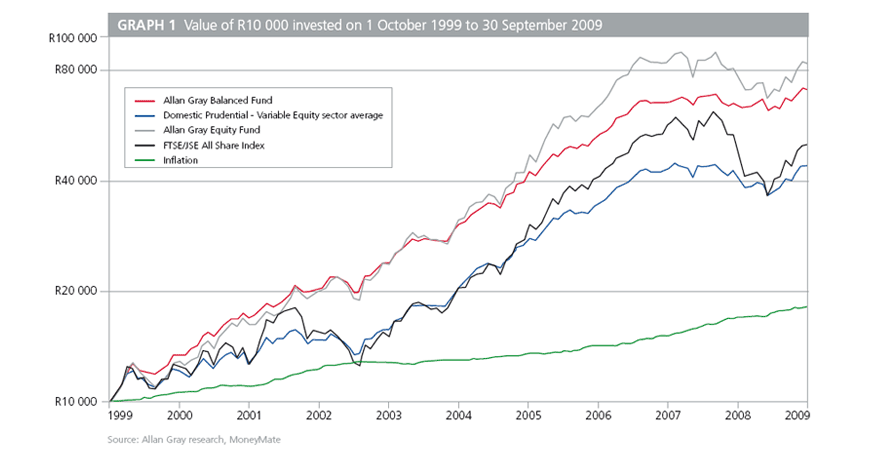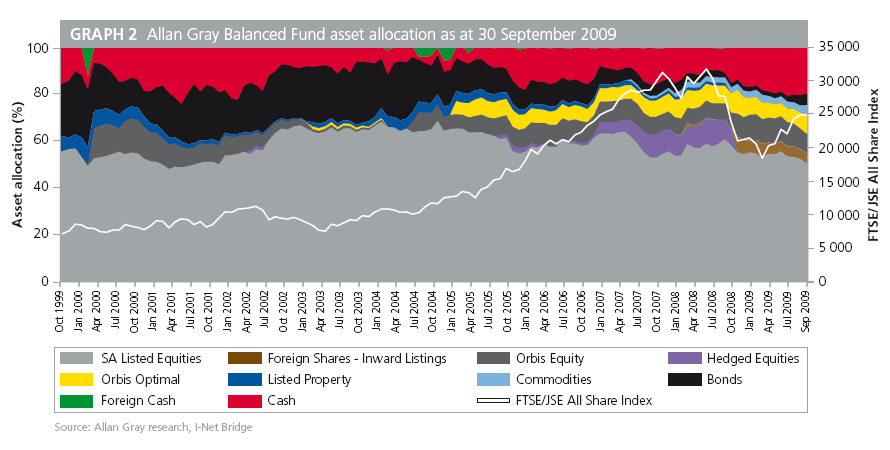On 1 October 2009 Allan Gray celebrated the 10-year anniversary of the Balanced Fund. Excluding the money market funds, at just over R29bn it is now the largest single unit trust in any South African sector. Jeanette Marais reminds us how the Fund's broad investment mandate allows the portfolio managers to reduce the volatility of the portfolio over the medium to long term, making the Balanced Fund a popular choice for retirement products.
The Allan Gray Balanced Fund proudly celebrates its 10-year anniversary this month, having achieved an annualised return of 21.8% since its inception on 1 October 1999. This means that an investment of R10 000 on 1 October 1999 at the opening unit price of R10 would have grown to R71 598 after fees and with distributions re-invested at the closing price of R49.19 on 30 September 2009. As shown in Graph 1, the average fund in its sector (Domestic Prudential – Variable Equity) achieved an annualised return of 16.1% over the same period, with a R10 000 investment growing to R44 579. The same investment in the FTSE/JSE All Share Index (ALSI) would have achieved an annualised return of 17.7%, growing to R50 819 (before fees but with dividends re-invested).

Why a balanced fund may be the right investment choice for you
If you are looking to diversify your investment portfolio, you are probably aware that you should include a spread of assets such as cash, shares, offshore investments, property and bonds. But what percentage of each would work best to deliver returns? And will you know exactly the right time to ease out of equities and increase, for example, your cash component? Allocation between different classes of assets in an investment portfolio can be very challenging. A better bet for many investors who wish to invest in a range of asset classes, and are happy to delegate their asset allocation decisions, may be to invest in a balanced fund. Balanced funds, like equity funds, have the capacity to create wealth over time and not just to preserve wealth.
But they are not as high risk as equity-only funds, as their broader investment mandate allows other asset classes to be included in the portfolio, enabling the portfolio managers to reduce volatility. The Allan Gray Balanced Fund is limited to a maximum equity exposure of 75%, and although it has never had less than 48% exposure to equities, its mandate allows it to have no exposure to equities at all. Although pure equity mandates should produce higher returns over the long term, the Allan Gray Balanced Fund has outperformed the Domestic General Equity Sector over its full history, but with considerably lower volatility and risk.
EXCLUDING THE MONEY MARKET FUNDS, AT JUST OVER R29BN [THE BALANCED FUND] IS NOW THE LARGEST SINGLE UNIT TRUST IN ANY SOUTH AFRICAN SECTOR
Approaches to asset allocation
There are two different schools of thought when it comes to asset allocation – managers either use a top-down, or bottom-up philosophy. The top-down school of thought starts with a macro view of the economy. Economists forecast views on the economy, sectors, currencies and interest rates. Then they make a call on which sectors should be overweight or underweight the ALSI. From there analysts seek out appropriate shares.
The bottom-up school of thought manages investments the opposite way around – and this is the school of thought we subscribe to. It is our experience that understanding companies, and investing in them when their fundamental value is less than their market value, is more rewarding than trying to predict economic, political or share-market trends. Fundamental value is the value a prudent businessman would place on a business. This involves detailed analysis of the business, its income, expenses, outlook and positioning within its industry. Our research results in portfolio manager decisions to hold individual companies, or to keep funds in bonds, property or cash. And the sum of all of these individual, bottom-up investment decisions is the asset allocation of the Fund. Our company research – including many conversations with senior management – also ultimately gives us a rounded view of the state of the economy, which we can use as a check on the bottom-up allocation.
The Balanced Fund's asset allocation varies over time
Graph 2, shows how the Fund's asset allocation has changed over the years. By examining the asset allocation over the last year, you can see how we have responded to the global financial crisis. Between January 2007 and September 2008 the Fund reduced equity exposure, taking advantage of the strong performance of the ALSI. The Fund used stock market hedging to achieve this. This trend continued until October 2008, a month characterised by extreme volatility in asset prices as investors tried to adjust to the concept of a world recession. During this month, the Fund took advantage of the weakness in the equity market to close out its hedge against stock market declines. This had the effect of increasing the net equity exposure of the Fund.
Under normal circumstances we would reduce exposure to shares by selling shares, not by stock market hedging. However in the middle of 2008 we were faced with the unusual combination of A: very demanding valuations in many of the largest shares in the ALSI, and B: relatively attractive prices in the defensive shares that we held. Keen to take advantage of this valuation difference, yet pessimistic about the market as a whole, our portfolio managers unusually decided to reduce exposure through hedging.
Many of you will be aware that for some time now we have used our full offshore exposure limit. On average, South Africans spend about 40% of their income on imported goods, but legal restrictions limit us to a maximum 20% offshore exposure. We are currently taking full advantage of this holding through the Orbis funds and foreign shares that are inward listed (classified as foreign but listed on the JSE, such as Mondi and British American Tobacco).

The Balanced Fund showcases our best ideas
Regular readers of our investment commentary will know that we generally do not broadcast a 'house view' and we shy away from making economic predictions. However, those curious about our view of the world need not look much further than the Balanced Fund's asset allocation to get a few clues. For example, keeping an eye on the Fund's allocation to local shares relative to a neutral point of about 60% will tell you when we find South African equities attractive, and when we do not.
Note that when there is not a significant difference in the value of the different asset classes, the Balanced Fund will tend to be overweight in equities, as this asset class allows us to add more value to the portfolio. (More detail on the Fund's quarterly disclosures can be found here).
Recently, the Fund has been steadily reducing its net equity exposure after the rapid rebound of global stock markets off their lows. The Fund's net equity exposure is currently down to 63.2% and its net exposure to SA equities is down to 50.6%.
Conclusion
More confident investors may decide to do their own asset allocation. You can do this by choosing individual building blocks – a bond fund, an equity fund, etc. – in varying proportions, depending on how you view the overall market. A balanced fund can do this for you, but with more peace of mind.